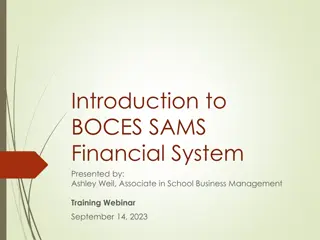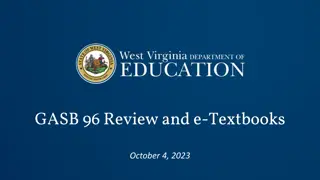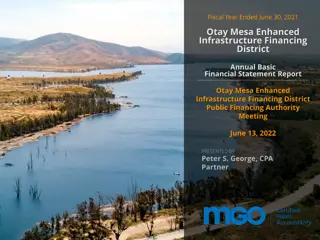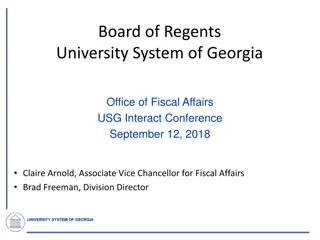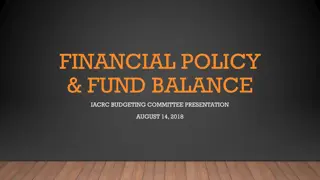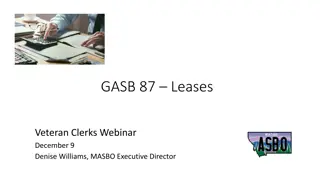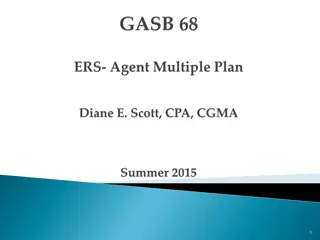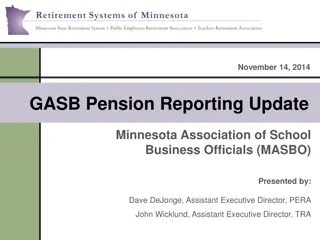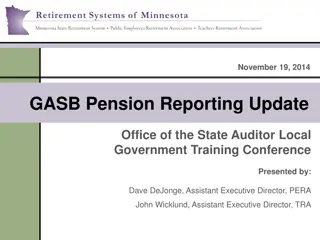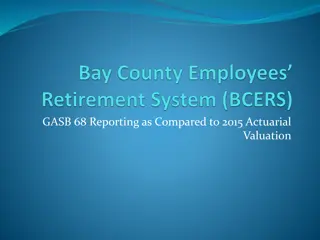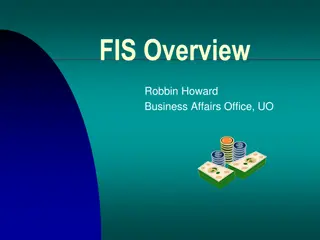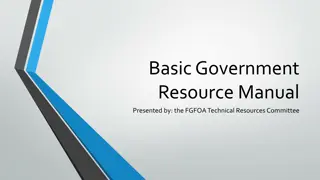Annual ST-3 Training for School Districts - GASB 96 Updates Fall 2023
This training program covers GASB 96 updates, General Fund Transfers, NRT updates, BOCES Expenditure Reporting, and filing ST-3 for school districts. GASB 96 focuses on Subscription-Based Information Technology Arrangements (SBITA), defining short-term and long-term contracts and how to account for
1 views • 76 slides
Introduction to BOCES SAMS Financial System Training Overview
This training session, presented by Ashley Weil, covers important topics such as GASB 96 guidance, SA-111 process, Federal Funding reminders, State Aid procedures, submitting BOCES State Aid claims, revising data in SAMS, understanding BOCES SAMS Financial Reports, and meeting submission deadlines.
4 views • 130 slides
Washoe County Investment Committee
The Washoe County Investment Committee recently discussed key principles for public fund investment programs, emphasizing the importance of long-term income generation, asset/liability matching, and prudent diversification. The presentation highlighted benchmarking strategies, budget stability consi
1 views • 25 slides
GASB 96: Subscription-Based Information Technology Arrangements (SBITAs) Overview
GASB 96 provides guidance on accounting for subscription-based information technology arrangements for government end users. It outlines criteria for determining control of IT assets, distinguishes SBITAs from leases, and explains the recognition and measurement of subscription liabilities and asset
0 views • 26 slides
Otay Mesa Enhanced Infrastructure Financing District Public Financing Authority Meeting Summary
The Otay Mesa Enhanced Infrastructure Financing District Public Financing Authority meeting held on June 13, 2022, discussed various agenda items including audit responsibilities, financial statements, upcoming GASB pronouncements, and audit standards. The responsibilities and deliverables of the au
2 views • 8 slides
Understanding GASB Statement 83: Asset Retirement Obligations
GASB Statement 83 standardizes the recognition and measurement requirements for asset retirement obligations (ARO) to enhance financial reporting consistency. Governments must recognize AROs when liabilities are incurred and reasonably estimable, based on external and internal obligating events. Mea
0 views • 30 slides
Financial Policy & Fund Balance Overview
This presentation highlights the importance of having a financial policy in place to protect cash reserves, make informed financial decisions, and ensure audit compliance. It explains the components of a financial policy as per GASB 54 and discusses the link between audited financials and the budget
0 views • 7 slides
Deposit and Investment Risk Disclosures for Accounting Professionals
Experienced Senior Auditor Michelle Kiese from BDO USA, Anchorage Office, discusses GASB 40 amendments and important risk disclosures related to credit risk, custodial credit risk, and concentrations of credit risk for deposit and investment transactions to provide users with valuable information fo
2 views • 17 slides
Understanding GASB 87 Leases: Key Information and Implementation Guidelines
This informational material focuses on GASB 87 Leases, covering aspects like the definition of leases, exclusions, accounting treatments, and implementation steps for government entities. GASB 87, issued in 2017, aims to enhance accounting and financial reporting for leases by governments through a
0 views • 23 slides
Understanding GASB OPEB Changes in Public Sector Health Care Benefits
GASB has introduced new standards for OPEB plans, similar to GASB 67/68 for pensions. The changes impact reporting and liabilities, requiring a blended discount rate and Entry Age Normal method. Employers must now carry the Net OPEB Liability on their balance sheets and provide extensive disclosures
0 views • 18 slides
Understanding OPEB Requirements and Accounting in School Finance
OPEB, or Other Postemployment Benefits, are benefits received by retired employees earned during their careers. GASB Statements 45, 74, and 75 provide guidelines for reporting and accounting for OPEB in school districts. Compliance with GASB 75 is mandatory for all districts to determine OPEB liabil
0 views • 35 slides
Financial Reporting Changes for Employer Retirement System
Transition to the new employer portal, requirements for employer portal design, audit approach memo, GASB Statement 68 report details, government employer participation issues, net pension liability reporting, and fiduciary net position changes are highlighted in this collection of information for p
0 views • 40 slides
GASB Pension Reporting Update for Minnesota - November 14, 2014
GASB updates impacting PERA and TRA pension reporting in Minnesota, including GASB 67 and 68 changes, implications for school districts and employer units, and major reporting changes affecting net pension liability.
0 views • 35 slides
GASB Pension Reporting Update and Implementation Insights
GASB updates and implementation guidelines for pension reporting as of November 19, 2014, presented at the Office of the State Auditor Local Government Training Conference. The update covers reporting deadlines for PERA and TRA, actuarial valuation reports, GASB Statement 68 impact on employer units
0 views • 41 slides
GASB 68 Reporting and Actuarial Valuation Comparison
GASB 68 reporting as compared to the 2015 actuarial valuation focused on the implementation of GASB 68 for financial statements, including the reporting of entities like the Bay County Employee Retirement System and Bay-Arenac Behavioral Health. The process involved providing information on pension-
0 views • 9 slides
Financial Management Overview at University of Oregon
Financial management at the University of Oregon involves various aspects including fund accounting, chart of accounts, proper resource allocation, and reporting standards set by GASB. Funds are classified into different types based on their sources, limitations, and characteristics. The university
0 views • 17 slides
Understanding Net Investment in Capital Assets and Its Importance
Net Investment in Capital Assets is a critical component of an entity's financial position, reflecting the value of capital assets owned. It represents the portion of the net position that is not spendable as it is invested in assets. Calculating Net Investment in Capital Assets involves subtracting
1 views • 17 slides
Understanding Capitalization Changes in Government Financial Management
The evolution of capitalization policies in governmental financial management, as guided by GASB, is explored through examples and implementation considerations. Key points include applying capitalization thresholds to groups of assets, considering aggregate significance, and planning for effective
0 views • 8 slides
Comprehensive Guide to Government Financial Management
This comprehensive guide, presented by the FGFOA Technical Resources Committee, covers topics such as accounting principles for local governments, annual financial audits, financial reporting, budgeting, and capital assets valuation rules. It explains the importance of audits in maintaining public t
0 views • 31 slides
Financial Management Roundtable Discussions at MACATFO Conference
Explore key topics discussed at the MACATFO Conference, including enhancement surveys, 1099 form improvements, GASB financial statement updates, grant tracking methods, mapping reviews, and upload templates usage. Join the conversation on critical financial management issues and advancements in the
0 views • 8 slides

